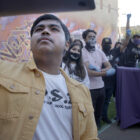During the 2008 Republican National Convention in Minneapolis, two young protesters from Midland, Texas, Brad Crowder and David McKay, were arrested on charges of plotting to carry out terrorist attacks using firebombs and got multiple-year jail sentences.
But the charismatic grassroots activist who inspired and, arguably, coaxed them to the brink of their alleged crime, Brandon Darby, suffered no legal fallout. On the contrary, his role in the pair’s downfall unveiled a shocking new incarnation of America’s post-9/11 security apparatus, one that is brought vividly to life in “Better This World,” winner for best documentary feature at this month’s San Francisco International Film Festival.
The film is scheduled to air nationally on PBS’s independent film series “POV” on Sept. 6. Bay Area-based co-directors Kelly Duane de la Vega and Katie Galloway spoke with SF Public Press about what drove them to make the film, what they learned in the process — and why the rest of us should care.
SF Public Press: You discovered the story in an article that appeared in the New York Times about an FBI informant’s disclosure of identity. What motivated you to want to make a film about it?
Kelly Duane de la Vega: It was an intriguing story and when we went to Texas to figure out what the full story was, bigger themes started to resonate: the post-9/11 security apparatus, the use of informants in the “war on terror.”
Katie Galloway: The government’s use of surveillance and the scope of what’s considered terrorism has changed since 9/11. There have been questions of entrapment and agent provocateurs in a lot of cases. From the article we read we knew that the accused so-called terrorists were from Midland, Texas, which is interesting because it’s George W. Bush’s hometown. We also knew that one of these two young men, David McKay, was headed for federal trial and he was going to be using an entrapment defense. So it was like, “Let’s take a look at one of these cases and see what actually happens — what’s behind a story where there are accused domestic terrorists and a claim that there was a provocateur?”
FBI informants had kind of a heyday in the upheavals of the 1960s. What would you say has changed about informants’ activities and even their legality since 9/11?
Galloway: After COINTELPRO and a lot of the extreme uses and abuses of informants in the ’60s, Senator Frank Church led the Church Committee hearings, which looked at how the government was using informants and scaled back the amount of leeway informants were given. But after 9/11 a lot of the concerns of the Church Committee went out the window. As FBI veteran James Weddick says in our film, “Before 9/11 it was eyes and ears only. Now it’s eyes, ears and the informant’s mouth.” How informants are used depends on what the Joint Terrorism Task Force thinks is necessary in any given situation, so the role of the informant is very ambiguous. But there’s no question that with the Patriot Act, after 9/11, the government was given much broader leeway in terms of surveillance and also in terms of the number, and application, of informants in terrorism cases.
One of the characters, a prosecutor in McKay’s case, says “It’s OK for the government to take them to the edge of the pool, but not to push them in.” So an informant can plant the idea of a crime, but can’t force them to follow through?
Duane de la Vega: Taking them to the edge can be planting the idea — as long as the informant doesn’t pull the trigger or say, “You’ve got to commit this crime.”
Young and politically passionate people are often lumped in the category of anarchist troublemakers at protests like these. Do you feel those people, and their ideas, are misunderstood, and was that also an important reason you made the film?
Duane de la Vega: I didn’t think of making this film as a way to humanize anarchists. It was more about our interest in the question of “What was the history behind these entrapment cases, and shouldn’t we be looking at that?” But if it has the effect of painting a more nuanced picture of activism, I don’t think that’s necessarily a bad thing.
Galloway: Anarchism is widely misunderstood; there are plenty of nonviolent anarchists. The Black Bloc, which is a group of black-clad protesters who sometimes engage in property destruction during protests, is a very narrow slice of anarchism. At the Republican National Convention, Brad and David did not see themselves as anarchists in any case. They weren’t claiming anarchism. So I think to see them as representatives of anarchism would be misguided.
The film brings starkly to mind two larger current issues: Guantánamo, with the orange jumpsuits that Crowder and McKay are forced to wear, and the current protest crackdowns in the Middle East, because of the footage of American cops brutally beating people in the streets during the convention. Do you feel Americans need to see more of these kinds of images to recognize that our own government also steps out of line in an authoritarian way at times?
Galloway: I think it’s really important for people to be exposed to what goes on in a visual, visceral way. If you think about the civil rights movement, when nonviolent protesters were brutally beaten in the streets and that was shown on television, or the issue of Life Magazine that showed all the soldiers who had died during one week in Vietnam — I think being able to see and understand visually what’s going on is really important. Also the huge amount of resources that are spent — when you hear the newscast saying, “F-16 jet fighters are in town” and that the FBI and every single agency will be involved after two years of planning, when you see hundreds of police in riot gear, the massive guns, and get a sense of the shock that protesters felt upon arriving and confronting the police state that was the RNC. I think it’s shocking for a lot of people who have not seen big public events after 9/11 up close. You get gasps from the audience about what the reality is on the ground.
Could there be a tipping point to the outrage your film exposes?
Duane de la Vega: There are more and more stories about informants. The New Yorker had one recently. And people in Portland are now questioning what happened with the Christmas Tree bomber, whether that was a case of entrapment. With all the individual stories, together they’re starting to tell a larger story. Whether we’re at the tipping point I don’t know, but I think people are starting to question some of the tactics. I think all of us want to be safe, and many of us support the FBI’s work in domestic and international terrorism, we but want to make sure they’re going about it in an effective and just way.
Galloway: I think the 10th anniversary of 9/11 is an opportunity to think about where we are and how to create a bigger conversation about the tensions between national security and civil liberties. This is a time to reflect, not just to buy into all the resources going into security, the prevailing methods, without questioning. That was the inclination close to 9/11 when people were so afraid they couldn’t think straight. With time there is potential to reflect more rationally.
The film’s style is distinct in its blend of prison interviews, family footage, documents, court testimony, archival video, phone conversations — even text messages.
Galloway: When we started we thought we were going to make a vérité film that began the day before trial and followed McKay and Crowder’s legal cases. It soon became clear that we had to tell the story of what had happened in the six months leading up to their arrests. At that point we focused on collecting all existing materials — how we could tell the backstory, what surveillance there was, what evidence existed from the case, the phone calls between David and his family — and we were able to bring the past alive through these vérité moments that we hadn’t been there to capture.
Is there a feeling that somehow these guys were simply foolish, duped or naïve?
Galloway: The strongest iteration of that is Brad Crowder’s own shock upon his arrest. He said, “I overlooked so many red flags,” and was stunned that he hadn’t seen the trap that he was falling into. With 20/20 hindsight everything seemed crystal clear. But it was too late.










